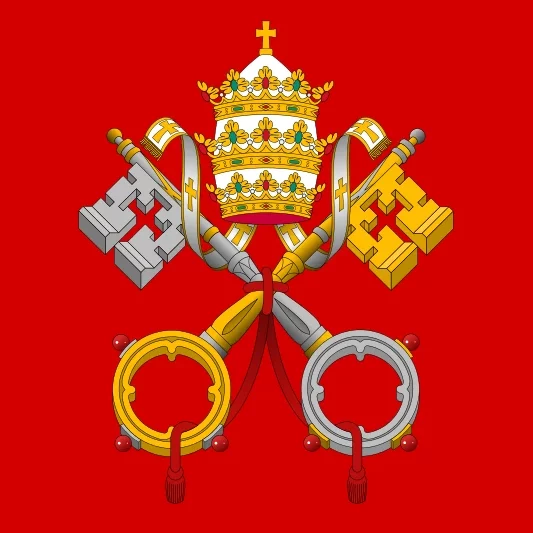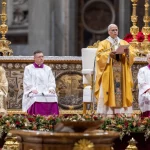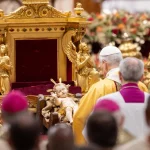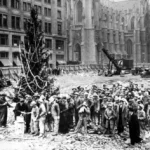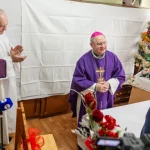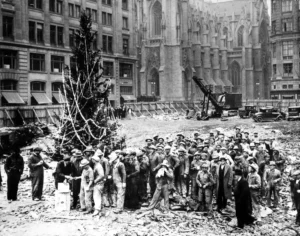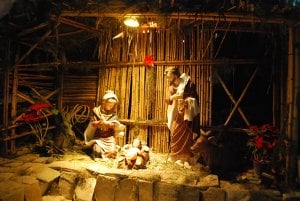Exactly 750 years ago on this date—December 6, 1273—Friar Thomas Aquinas received his supreme mystical experience that led to what Josef Pieper called “the silence of St. Thomas.” I maintain that more than coincidence unites this divine crowning of Thomas’s life with the devotional cultus of St. Nicholas, whose feast has always been celebrated in the West on the 6th, certainly long before the Angelic Doctor was born. Indeed, Thomas, toward the end of his life (c. 1269–71) preached a homily on the feast of St Nicholas, which begins with the verse: Inveni David (“I have found David, my servant”).[1]
In accord with a Thomist whom I admire, it seems to me worthwhile “to enliven dogmatic and pastoral theology with an infusion of hagiography and iconography”[2]—to see, with the eyes of faith, the marks of the bishop of Myra’s decisive intervention on that momentous day. While there is no question that the copious legends of yore should be approached with intelligent discrimination, it is in many ways worse if one loses the childlike capacity to accept the miraculous, revere the heroic, laugh at the comical, feed on the wisdom and follow the examples lovingly preserved in the accounts of God’s ambassadors, His holy fools.[3]
The background: the chapel of St Nicholas in Bologna
The story of St. Thomas’s decisive mystical experience at the close of his life has been told by all his biographers with varying shades of detail and diverse touches of art. In keeping with my focus on St. Nicholas, I will take this opportunity to highlight a number of details that taken together yield a whole greater than the mere sum of its parts.
For the sake of background, it bears mentioning that the priory of San Domenico in Naples held a unique place in Thomas’s life and, undoubtedly, in his affections. Having left Montecassino, Thomas enrolled in the fall of 1239 at the newly-created studium generale in Naples; he was then a youth of some fifteen years. It was at this time that he first encountered the “preaching brethren” in the persons of John of San Giuliano and Thomas of Lentini, the only friars who had been allowed to stay at the priory church after Frederick II’s expulsion of mendicants from his kingdom. It was at this Dominican priory that Thomas of Aquino received the habit from Thomas of Lentini no later than April 1244.[4] After his first Parisian regency (1252–1256) it is likely that Thomas returned to his home priory of Naples, from 1259 to 1261, before transferring to the priory in Orvieto.[5] And it was again to Naples that Thomas would return after his second Parisian regency (1268–1272).[6]
Thus, it would not be surprising had a special bond formed between Thomas and the community and church of San Domenico: it was there that the seed of his lifelong vocation was planted, there that he was clothed as a mendicant preacher, there that he returned after two demanding periods of teaching in the busy and seldom placid university milieu of Paris.
In his final period in Naples, mid-1272 to early 1273, Thomas chose for his special place of prayer a chapel dedicated to St. Nicholas in the church of San Domenico, where he celebrated his morning Mass and spent time in meditation prior to Matins.[7] We know of a layman who attended Thomas’s daily Mass—a man by the name of Nicholas Fricia.[8] The experience of December 1273 took place in this particular chapel, where the colloquy with the Crucified had taken place a few months earlier.[9]
It is therefore beyond doubt that Thomas, while living in Naples, had a decided preference for praying in this chapel, to which he repaired twice a day. Whether this preference may be taken to indicate a personal devotion to St. Nicholas or resulted, rather, from other circumstances—that the chapel happened to be a convenient or well-appointed or out-of-the-way place, that Thomas favored its altarpiece or crucifix, or some such thing—cannot, of course, be settled on the basis of the available evidence. The most valuable piece of evidence is the frequency with which, in his writings, Thomas speaks of Nicholas as compared with other saints of the same rank, which may well reveal to us an aspect of the friar’s devotional life.
But why Nicholas in particular?
I turn now to the experience of December 6. “While brother Thomas was saying his Mass one morning, in the chapel of St. Nicholas at Naples, something happened which profoundly affected and altered him. After Mass he refused to write or dictate; indeed he put away all his writing materials,” testified Bartholomew of Capua in the canonization inquiry.[10] His socius Reginald was anxious and alarmed; he wanted to see the Summa finished, and kept pressing his master to tell him what had happened. Had his master lost his mind from too much study?[11] He must somehow be persuaded to carry on with his work! “Reginald, I cannot. All that I have written seems to me like straw in comparison to the things I have seen, the things that have been unveiled to me.”[12]
Seeing that the experience occurred not only on the feast of Nicholas, as is probable, but also in the very chapel dedicated to him, as is certain, we have more than enough reason to wonder why divine Providence linked the destiny of Thomas to the patronage of Nicholas. “With God, there is no such thing as chance,” Padre Pio was in the habit of saying—whether aware or unaware that he was repeating an oft-stated view of Aquinas’s.[13] Even if our attempts to read God’s handwriting in history can meet with only partial success, our devotion to the Doctor of the argumentum ex convenientia impels us to make a suitable effort.
While all the saints lived heroically the theological virtues and the gifts of the Holy Spirit, each embodies them in a distinctive way. Consider the kind of saint this bishop’s life and works portray. He is a patron of sailors, captives, and poor brides. Nicholas is a saint of faith, interceding for those who embark upon treacherous voyages trusting in God’s help. He is a saint of hope, helping those who long to be delivered from prison. He is a saint of charity, giving of his substance to ensure that the bride may be presented to her spouse “in splendor . . . holy and without blemish” (Eph. 5:27). The old Roman antiphon at Communion compares him to the sun, the moon, and the rainbow—the sun which from afar gives light to this lower world (fides), the moon which reflects the light of the sun of glory and anticipates it (spes), the rainbow which, joining earth and heaven, stands as symbol of the covenant between man and God (caritas).[14] The Communion antiphon in the Dominican use calls him the servant who is blessed to be found vigilant when his Master comes: watching in faith, sustained by hope, his heart occupied with the one thing needful.
Sailor, captive, lover of God
How fitting that this saint should have intervened so dramatically in the life of Friar Thomas! For there is no voyage more perilous than launching into the depths of God. Searching for what the Fathers have said about the divine name “He who is,” Thomas seizes upon the striking phrase of St. John Damascene: “comprehending all in itself, it contains being itself as if an open sea of substance, boundless, indeterminate”—a text Thomas quotes on four occasions, from the Sentences to the Summa.[15]
Not God alone, but the works of Christ, too, are named a sea: “Mark how great a multitude of persons healed the Evangelists pass quickly over, not mentioning them one by one, but in one word traversing an unspeakable sea of miracles.”[16] One is reminded of the saying of St. Athanasius: “such and so many are the Saviour’s achievements that follow from His Incarnation, that to try to number them is like gazing at the open sea and trying to count the waves.”[17] And while Thomas is no Platonist who scorns the body as if it could only be a prison, he also makes his own the cry of the languishing lover held back from the full enjoyment of his beloved: “For me to live is Christ, and to die is gain. . . . I long to be dissolved and to be with Christ” (Phil. 1:21, 23),[18] “Who will free me from this body of death?” (Rom. 7:24)—the pilgrim whose heart aches with hope of safe haven, stung with remembrance of his true patria by the God-reflecting beauty of this world.[19]
As much as his master St. Paul, this religious metaphysician is a captive and slave of Christ, in whose body “dwells all the fullness of the Godhead.” Thomas was a slave of love, and what he loved he in part saw, but that vision drew him on to the limits of his strength and even beyond. And so he wrote the Summa, but could not, to his eternal honour, complete it; and perhaps the best comment on the great silence that envelops the last months of St. Thomas’s life will again be found in words of St. Paul: “Not that I have already attained to it, that already I am perfect; but I press on to make it my own, as Christ Jesus has made me his own.”[20]
The traditional Epistle and Gospel for the Feast of Nicholas stress the theme of passing over from this life into the next. “We have not here a lasting city, but we seek one that is to come” (Heb. 13:14). “Enter thou into the joy of thy Lord” (Mt. 25:21). The body as such is no prison, but this mortal life is truly something to be delivered from. “Through such conceptions of ours God Himself is not seen as He really is, but is understood to be beyond understanding”; “while on pilgrimage our intellect does not attain to the very essence of his goodness,” writes Thomas the young baccalarius.[21] “God cannot be seen in his essence by a mere man unless he be separated from this mortal life,” repeats the older magister in his last great work.[22] Although the believer is “liberated by the simple truth which always abides in the same way,” and like a ship gliding over calm waters is “not tossed about by the unstable and changeable winds of diverse errors,”[23] the state of pilgrimage keeps the intellect plunged in the darkness of faith, restless to see the One in whom it believes.
But faith and hope are nothing, all gifts and trials nothing, unless they are quickened by charity. Charity turns the soul to her Lord, the bride toward the bridegroom, and unites their wills in friendship—preparation in the realm of time for the soul’s eternal embrace of her spouse, when at last it can be said unconditionally, “I am my beloved’s and my beloved is mine” (Song 6:2).[24] The lover of God longs to lose himself in that “open sea” which, when seen, is no formless, dizzying expanse, but a face and a heart, the Face of the Lord, the Heart of Jesus.
The voice of the Crucified Savior
Regarded with eyes of simple faith, there is every reason then to believe that Friar Thomas received his vision during Mass on the morning of December 6, 1273, through the intercession of St. Nicholas, who rescues the seafarer, frees the captive, dowers the bride. Celebrating the sacred mysteries in honor of the great bishop, the Angelic Doctor was borne out of himself in an ecstasy of love that crowned his life of faith, suffering with such intensity the divine things about which he had preached and written, that he could barely speak, let alone write. This foretaste of glory is a fitting sequel to the tribute “You have written well of me, Thomas”: the writings are given for no other purpose than to lead us to this glory.
That these earlier words of praise had been projected from a crucifix in the chapel of St. Nicholas is significant in many ways. One stands out in connection with December 6. It was on the cross that our Lord’s divinity was most of all hidden to the world, his wisdom most of all foolish.[25] There could be no moment in the life of Christ more favorable to the rationalism of Arius, who revered Christ as “a son of God,” a creature uniquely favored and full of grace, martyred on Calvary as a model of unselfish love. But Nicholas, who “so far forgot himself as to give the heresiarch Arius a slap in the face,”[26] rightly rejected this “death-dealing poison.” If there is one truth around which Thomas centered his life, it was this: “In the beginning was the Word, and the Word was with God, and the Word was God . . . The Word became flesh, and dwelt among us, full of grace and truth; we have beheld his glory, glory as of the only Son from the Father” (Jn. 1:1, 1:14).[27] “We destroy arguments and every proud obstacle to the knowledge of God, and take every thought captive to obey Christ” (2 Cor. 10:5). Jacques Maritain appositely remarks:
The peculiar task of St. Thomas, the undertaking to which he was appointed by the Lord, was to bring the proudest and most intractable (because the most spiritual) of powers—I mean the mind, in all its apparel of riches and majesty, armed with all its speculative energies, all its logic and science and art, all the harness of its fierce virtues which are rooted in being itself—to bring the mind (by compelling it to sobriety but never to abdication) whole and entire into the holy light of Christ, to the service of the Child-God lying in the manger between the ox and the ass. He has all the Magi behind him for the rest of time.[28]
It would be difficult to imagine a more zealous lover of the full theandric reality of Jesus Christ than St. Thomas, who bows his head and bends his knee before the Incarnate Word, before applying his intellect to expounding this mystery out of Scripture and Tradition.
As a boy Thomas is said to have refused to let go of a piece of paper on which the words Ave Maria were written; as a dying man, he spoke to Cistercian monks of the Song of Songs, the epithalamium of Christ and the Church.[29] From start to finish, the Incarnation—in its historical reality, in its Eucharistic and ecclesial continuation, in its eternal truth—was the source and summit of his life, his prayer, his thinking. There is no disciple of Aquinas’s work who does not sooner or later discern the gentle presence of Jesus as master and friend wherever the bread of sacred doctrine is broken and handed out. For him as for all the Fathers of the Church, theology is inseparable from a richly sacramental Christology—“the light of the knowledge of the glory of God in the face of Christ Jesus” (2 Cor. 2:14), “in whom are hid all the treasures of wisdom and knowledge” (Col. 2:3), “the mystery hidden for ages and generations but now made manifest to his saints” (Col. 1:26), “the living bread which came down from heaven . . . for the life of the world” (Jn. 6:51).
St. Thomas’s response to the Crucified, “Nothing but yourself, O Lord,” and his deathbed confession before the saving Victim, “for love of whom I have studied and toiled and kept vigil,” throw into bold relief the inner character of both the man and his work. With magnificent insight Maritain draws together these different threads. By being not only “the prince of metaphysics and sacred learning” but also “the doctor of the Blessed Sacrament,” St. Thomas
thus achieves and consummates his function of servant of the eternal Word, the Word which enlightens the mind, the Word which is the archetype of all splendour, the Word which became incarnate and is hidden in our midst under the whiteness of bread. . . . It is the same Truth which is eager to give itself to us all in light and in substance in the beatific vision and which meanwhile gives itself in light through doctrine and contemplation, in substance through the Eucharist . . . And was it not with one same love that Thomas preserves its integrity in doctrine, which is the created participation of primary Truth, and adored its presence in the Sacrament, the personification of primary Truth?[30]
Theology is child’s play
A final question. Why did Thomas experience the fulfillment of his theological aspirations on the feast of the saint under whose patronage gifts are given to little children each winter?[31] The question’s anachronism is considerably lessened by the fact that God, the giver of every good gift (cf. Jas. 1:17), stands utterly outside of time. An answer is implicit in the accounts of Thomas’s last days, which, remarks Saward, “are truly moving to read.”
The big, heavy man, as silent and still as a babe asleep; the scholar at last without his pen. We can see Thomas and Reginald together, the friend anxious but finally accepting, the saint lost in contemplation of the divine beauty. By the “faithful testimony” of Reginald we are told that the last confession of Thomas was like that of a “five year old boy”, suggesting not only the purity of infancy but also that childlike trustfulness commended by the Lord, who reveals his mysteries not to the clever but to babies.[32]
In the winter of this life’s pilgrimage, the wintry dark from which the eternal summer of heaven seems impossibly distant, God comes with light and warmth to men and women who are, in their hearts, little children, relying upon Him and trusting in Him no matter what the season’s weather may bring. God pours out the riches of His fatherly love most abundantly on the most childlike, who attract His gaze by their open-eyed wonder, their confident trust, their never-ending flood of questions, their innocent joy.
Fr. Brian Davies writes that St. Thomas
moves from question to question with a breathtaking eagerness. He is always asking “Why?” or “What?” One might even say that Aquinas’s whole system rests on a question. … God, for him, is an answer to puzzlement (admiratio), an answer which leaves us with yet more questions.
What is more typical of a normal child than a stream of questions that runs dry only when adults grow impatient or cannot think of what to say? The model of the trusting, inquisitive child who “asks, seeks, knocks” is both the point of departure for discovering God and the point of arrival in the heavenly kingdom, where he who asks will be answered, he who seeks will find, and he who knocks will have the door opened unto him.
Fr. Saward again comments: “In the exercise of his science, as in the conduct of his life, the theologian must convert and become like a child, recovering and preserving a sense of astonishment at the grandeur of what God has revealed in His Son.”
The Savior seals His nuptial covenant with the pure of heart who seek the one thing necessary. To be a theologian is to be in love with the truth of God, to give oneself confidently and humbly to that truth which anticipates us at every step. Fr. Thomas Gilby reminds us of the personal presence that gives theology its very meaning: “The Word and the Spirit of Love are sent to us, and all the words of the science of faith and all affections within divine friendship are so many echoes and refractions of their presence.” The exemplar and fulfillment of theology is the beatific vision—a vision of the infinitely great by the infinitely small, the Creator who is Father by the creature who is His child, the Savior who is bridegroom by the saint who is His bride.
A biographer of St. Thomas, Fr. Martin Grabmann, attempts to put this “theology of the blessed” into words:
Their total knowledge and love are uninterruptedly ordered in one continuous act toward God, the unveiled divine Love, whom they contemplate face to face. Their whole activity and life are an eternal, ineffably brilliant, glowing, and blessed ecstasy of love in this vision, enjoyment, and embrace of the infinite triune God.
In his sermons on the Apostles’ Creed, St. Thomas defines eternal life as the definitive union of man with God, which means seeing God face to face, giving Him perfect praise, enjoying the superabundant fulfillment of all desire and an inconceivable delight, “knowing all natures of all things, and all truth, and whatsoever we wish to know, as well as possessing whatsoever we desire to possess.” It brings with it perfect security, without sorrow, toil, or fear, and the pleasant fellowship of all the blessed, magnifying the joy of each into the joy of all.
This is the paradise St. Nicholas of Bari won by practicing the mercy, humility, and faithfulness God had poured into his heart. This is the paradise St. Thomas Aquinas won by living the same virtues. Each in due course became a great saint and preacher of wisdom by turning to become a little child and a fool for Christ. May we, by doing the same here and now, join these two merry men in their eternal rejoicing.
[1] The full text, with notes, can be found here.
[2] John Saward, The Beauty of Holiness and the Holiness of Beauty (San Francisco, Ignatius Press, 1997), 24.
[3] See John Saward, Perfect Fools: Folly for Christ’s Sake in Catholic and Orthodox Spirituality (Oxford, Oxford University Press, 1980; repr. 2000).
[4] Jean-Pierre Torrell, Saint Thomas Aquinas: The Person and His Work, trans. R. Royal (Washington, DC, The Catholic University of America Press, 1996), 4–12.
[5] Torrell, Thomas Aquinas, 96–101; 118.
[6] Torrell, Thomas Aquinas, 247–49.
[7] See Torrell, Thomas Aquinas, 285. The original location of the chapel of St. Nicholas within the church differed from its present location, which dates from the rebuilding and reconfiguration of the church in 1283. Hence, the memorial tablet that announces “Sacellum hoc in quo D. Thomas Aquinas responsum a Cristo Domino audire meruit” etc., does not actually specify the correct location, although it has a kind of appropriateness given the continuity of patronage between the old chapel and the new.
[8] As reported by Bartholomew of Capua: “a domino Nicolao Fricia, qui intrabat scholas dicti fratris Thome et omni die ibat ad audiendum missam in dicto loco fratrum Predicatorum, quod idem frater Thomas, omni die, summo diluculo, celebrabat missam in capella sancti Nicolai.” A. Ferrua, ed., Thomae Aquinatis vitae fontes praecipue (Alba, Edizioni Domenicane, 1968), 315.
[9] A sacristan at San Domenico, Dominic of Caserta, bore witness that, on one occasion during these last months of 1273, he saw Friar Thomas rapt in prayer before the chapel’s crucifix, which spoke to him in a clear voice: “You have written well of me, Thomas; what do you desire as a reward for your labors?” The friar replied: “Yourself alone, Lord.”
[10] Kenelm Foster, The Life of Saint Thomas Aquinas: Biographical Documents (Baltimore: Helicon Press, 1959). “Cum dictus frater Thomas celebraret missam in dicta capella sancti Nicolai Neapoli, fuit mira mutatione commotus, et post ipsam missam nunquam scripsit neque dictavit aliquid, immo suspendit organa scriptionis in tertia parte Summe, in tractatu de Penitentia” (Ferrua, Fontes praecipue, 318).
[11] This is just the phrase we read in the account: “timens ne propter multum studium aliquam incurisset amentiam” (Ferrua, Fontes praecipuae, 319).
[12] “Raynalde, non possum. Omnia que scripsi videntur michi palee respectu eorum que vidi et revelata sunt michi” (Ferrua, Fontes praecipuae, 319).
[13] See, e.g., ST I, q. 22, a. 2; q. 103, a. 5 and a. 7, ad 2; q. 116, a. 1; Summa contra gentiles III.92.
[14] The text of the antiphon: “Semel juravi in sancto meo: semen ejus in aeternum manebit: et sedes ejus sicut sol in conspectu meo: et sicut luna perfecta in aeternum: et testis in coelo fidelis” (Ps. 88:36–38). I interpret the last phrase, “witness in the skies,” as a reference to the covenant made with Noah after the flood and symbolized by the “bow in the clouds” (Gen. 9).
[15] The first text (Sent. I, d. 8, q. 1, a. 1, ad 4) is also one of the most well-known of Aquinas’s apophatic confessions. Other occurrences: De potentia q. 7, a. 5 (Quaestiones Disputatae, Marietti ed., 2:199); De potentia q. 10, a. 1, ad 9 (Marietti ed., 2:256); ST I, q. 13, a. 11.
[16] ST III, q. 43, a. 4, quoting John Chrysostom.
[17] Athanasius, On the Incarnation (Crestwood, NY, St. Vladimir’s Seminary Press, 1993), 93.
[18] Thomas calls this attitude of Phil. 1:23 the highest degree of charity, its peak intensity: see ST II-II, q. 24, a. 9.
[19] Cf. In librum Beati Dionysii De divinis nominibus, cap. 4, lec. 5, n. 337; Sent. I, d. 27, q. 2, a. 2, qa. 2, ad 3.
[20] Foster, Introduction to Life of Aquinas, 22–23, citing Col. 2:9 and Phil. 3:12-13.
[21] Sent. I, d. 2, q. 1, a. 3, ad 2; Sent. IV, d. 48, q. 1, a. 3.
[22] ST I, q. 12, a. 11. It is like a refrain in questions 12 and 13 of the Prima Pars. Other texts that make the same point include Summa contra gentiles I.30 and III.49; In Boetium De Trinitate expositio 1.2; In Post. analyt. 2, lec. 1.
[23] See In librum Beati Dionysii De divinis nominibus cap. 7, lec. 5, n. 739.
[24] Though not as prominent in his theology of charity as the notion of amicitia adapted from Aristotle’s Nicomachean Ethics, the language of “bridal mysticism” so familiar in monastic spirituality is by no means rejected by St. Thomas, but contributes an essential dimension to that theology. Examples of this language include Super Ioan. 12, lec. 5, n. 1673 (Marietti ed., 313); ST II-II, q. 19, a. 2, ad 3; De virtutibus q. 2, a. 12, obj. 24 and Sent. IV, d. 31, q. 1, a. 2, obj. 2 (as undisputed premises in both places); Sent. IV, d. 26, q. 2, a. 1, ad 3.
[25] Cf. 1 Cor. 1:17–31; 2:7–8. In human judgment, it is the antithesis of glory; in the Lord’s purpose, it is the revelation of glory (cf. Jn. 17:1, 21:19).
[26] Butler’s Lives of the Saints, ed. Herbert J. Thurston and Donald Attwater (Westminster, MD: Christian Classics, 1990), 4:504.
[27] “I and the Father are one” (Jn. 10:30); “He that sees me sees the Father also” (Jn. 14:9). Cf. Mk. 14:61–62, Lk. 4:41, Jn. 17:5 and 17:24, 1 Cor. 1:24, 2 Cor. 1:19, Col. 1:13–20. That Peter and Paul appeared in a vision to Thomas when he was wrestling with the meaning of Isaiah is easily believed, for the theologian who, at the end of his life, tasted something of the rapture of Paul and heard an echo of the same arcana verba (2 Cor. 12:4) had throughout his life humbly made his own the confession of Peter: “Thou art Christ, the Son of the living God” (Mt. 16:16). Cf. Jn. 6:70, 11:27, and 20:31; Acts 8:37. On the vision, see Foster, Life of Aquinas, 39.
[28] Jacques Maritain, St. Thomas Aquinas, Angel of the Schools, trans. J. F. Scanlan (London, Sheed & Ward, 1942), 99–100.
[29] As recounted in the Vita of Bernard Gui (cf. Foster, Life of Aquinas, 55). Incidentally, among the monks crowded into the dying friar’s room, mention must be made of three Nicholases who later participated in the canonization process: Nicholas, future abbot of Fossanova, Nicholas of Fresolino, and Nicholas of Piperno. See Torrell, Thomas Aquinas, 269 and 291; Foster, Life of Aquinas, 84–86. For a comment on the story of the Ave Maria parchment, to which (curiously?) there corresponds a similar story in a medieval vita of St. Nicholas, see Torrell, Thomas Aquinas, 283, note 79.
[30] Maritain, Angel of the Schools, 118.
[31] True, it is only by a bizarre coincidence that he became associated with children—namely, the misinterpretation of the bags of gold as the severed heads of infants to whom Nicholas restored life (cf. Butler’s Lives 4:504; 506).
[32] Saward, Perfect Fools, 83–84.
